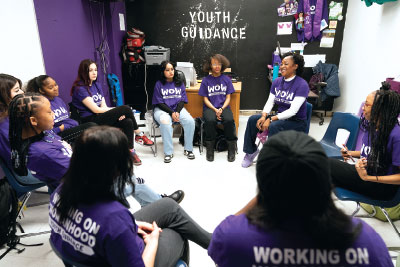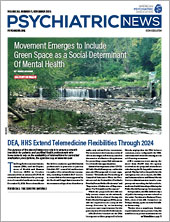In September 2016, following a spike of gun violence in Chicago, Mayor Rahm Emanuel announced a
new public safety plan that featured a three-year, $36 million initiative to provide mentoring and psychological support to middle- and high school–aged boys in at-risk neighborhoods.
The mayor’s plan was met with a mixed response, with some community advocates and researchers wondering why the program shortchanged programs for girls.
“Girls are absolutely overlooked in school and community settings,” said Nacole Milbrook, Psy.D., the chief program officer at
Youth Guidance, a Chicago-based nonprofit that creates and implements school-based programs to help students succeed in school and life. “Girls affected by violence and trauma tend to act in as opposed to act out; if you are not creating a problem, the perception is you don’t need intervention.”
That perception could not be further from the truth, noted Monica Bhatt, Ph.D., research director at the University of Chicago’s Crime Lab and Education Lab. “We did surveys of 9th, 10th and 11th grade girls in schools [from neighborhoods] experiencing high rates of gun violence and found that nearly 40% had symptoms of distress consistent with probable PTSD [posttraumatic stress disorder],” she said. “That is twice the rate seen in veterans returning from Iraq or Afghanistan, which is very sobering.”
To offer support to these and other girls, Youth Guidance created a program called
Working on Womanhood (WOW). WOW is a school-based, trauma-informed group counseling program designed by Black and Latinx women for Black and Latinx girls. The program serves students in schools in Chicago, Boston, and Kansas City, but the results of a recent feasibility study showcase a broader potential.
Students Experience Mental Health Improvements
Working on Womanhood—which was created in 2011 by a team of social workers at Youth Guidance—is shaped by principles taken from cognitive-behavioral therapy, acceptance and commitment therapy, and narrative therapy. The weekly group sessions are led by master’s-level counselors, who offer lessons centered around one of five core values: self-awareness, emotional intelligence, healthy relationships, visionary goal setting, and leadership. The counselors can provide individual therapy and/or refer students for additional services, if needed.
The program is offered as a class once a week onsite at participating schools during the school day throughout the academic year (39 sessions total).
Milbrook told Psychiatric News that a big part of the program’s success comes from the counselors. “What we are looking for is the right combination of passion and skill; we want counselors with training and knowledge, but also some lived experience with these neighborhoods.”
The success of WOW also stems from Youth Guidance’s commitment to regularly evaluating the effectiveness of the program and taking steps to strengthen it, said Bhatt, who has been involved in studying the impact of the program on the adolescent girls it serves.
“The organization took the time to create a clinical intervention that was responsive to the needs of girls, adapted it to be delivered in a school setting, and then worked with the Education Lab as external evaluators to understand whether or not the model worked to reduce PTSD, anxiety, and depression,” Bhatt explained. The results of this evaluation were published earlier this year in Science Advances.
As part of a randomized trial, Bhatt’s team worked with Chicago Public Schools and Youth Guidance to identify 10 public high schools located in communities experiencing high rates of gun violence across Chicago. Selected schools agreed to provide WOW beginning in the 2017-2018 academic year. These schools then used a lottery to offer spots in the WOW classes to 50 students in grades 9 through 11 per school. Girls who attended school at least 75% of the time during the prior year and did not have intellectual disability disorder or signs of aggression, self-harm, or suicidal ideation were eligible for the WOW class. Overall, 1,232 girls were offered access to WOW while 2,517 peers had access to standard school services and electives. About 85% of the students in the study were Black and/or Hispanic, and about 95% were eligible for free or reduced lunch.
Prior to the school year, 626 students—equally divided between WOW and control—were randomly selected to fill out a comprehensive baseline survey on mental and physical health measures (55% responded); about 2,000 girls were then randomly selected for a follow-up survey sometime between May and November 2018 (84% responded).
At the start of the study, many of the participants reported, on average, at least two serious traumatic experiences: nearly 30% had personally witnessed someone being attacked, stabbed, shot at, hurt badly, or killed, and more than 45% had someone close die suddenly or violently.
Bhatt and colleagues found that relative to their student peers, girls who participated in WOW experienced a 22% drop in PTSD symptom severity, a 14% drop in depression severity, and a 10% drop in anxiety severity from baseline to follow-up. WOW did not appear to have any effects on the girls’ academic or disciplinary outcomes, but Bhatt said that this was not surprising.
“On average, these girls were coming in with solid attendance and a B average, which is admirable considering the high rates of trauma exposure we found,” Bhatt said.
The overall cost of WOW at these schools was calculated at $2,300 per participant. Based on quality-of-life measures, an analysis showed that the program was highly cost-effective.
“Of course, something may be cost-effective, but if it requires a large percentage of a school’s yearly operating budget then it’s still cost-prohibitive from a district’s perspective and not likely to be implemented,” Bhatt noted. “One challenge now is how to lower the cost [of WOW] even further without compromising its effectiveness to make it available to more students.”
Program Looks to Expand
For those intimately involved with Working on Womanhood, the findings of Bhatt’s study were hardly surprising.
“I would not be where I am today without WOW’s help,” said Precious Omomofe, a senior and neuroscience major at Pomona College in Claremont, Calif. Omomofe, who started the program as a sophomore in high school, had to deal with the dual difficulties of living in a community experiencing gun violence while also attending a school with a small Black student population, thus feeling like an outsider.
“I would have never even thought about such counseling resources if they weren’t so readily available,” Omomofe continued. “In my family, mental health was not a topic of discussion.” She recalled one of her early sessions with WOW when she broke down crying as she realized how overwhelmed she felt. “The staff were all so amazing and helped me succeed,” she said.
Milbrook said that she is elated to see the positive outcomes on mental health that the Chicago program seems to be having on girls in the city now backed by scientific evidence. And while WOW programs have since expanded to schools in Boston, Dallas, and Kansas City, Milbrook hopes more schools will soon follow.
“Now is the time to act,” she said. “Remember, the stark data in the study came from 2017 and 2018; since COVID hit mental health issues among high schoolers have only gotten worse.”
The Science Advances study was supported by the AbbVie Foundation; Arnold Ventures; Paul M. Angell Family Foundation; Edna McConnell Clark Foundation; Logan; MacArthur; Polk; and a grant from the U.S. Department of Justice. ■


